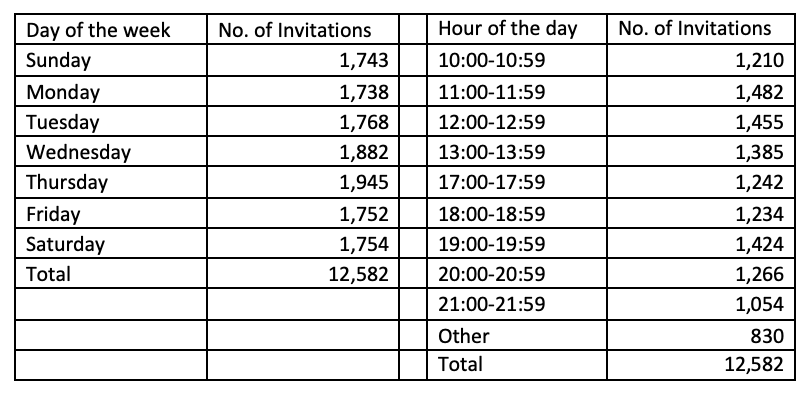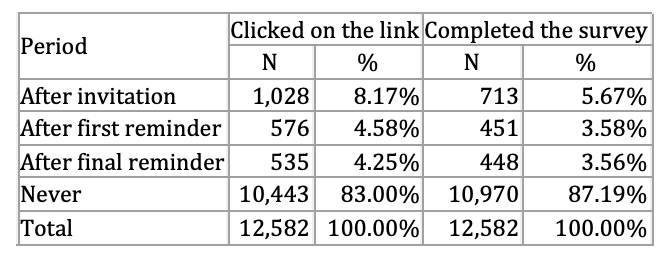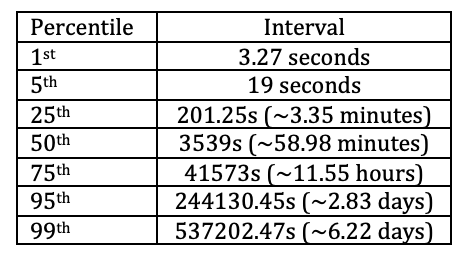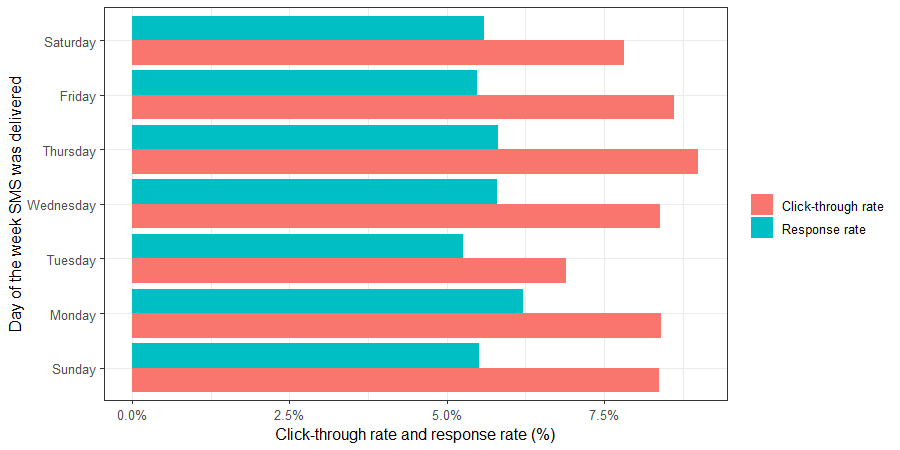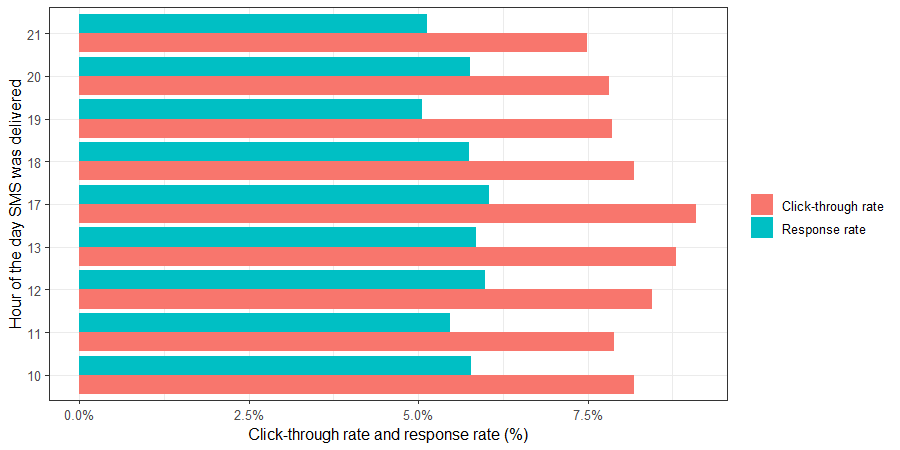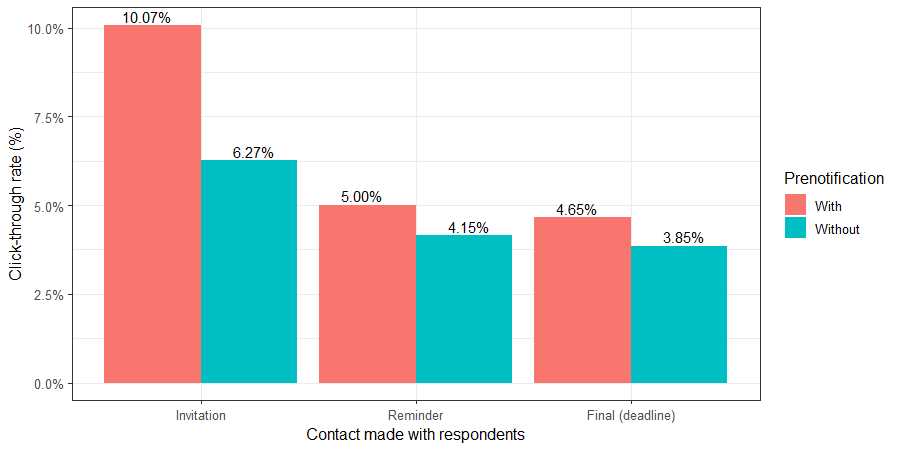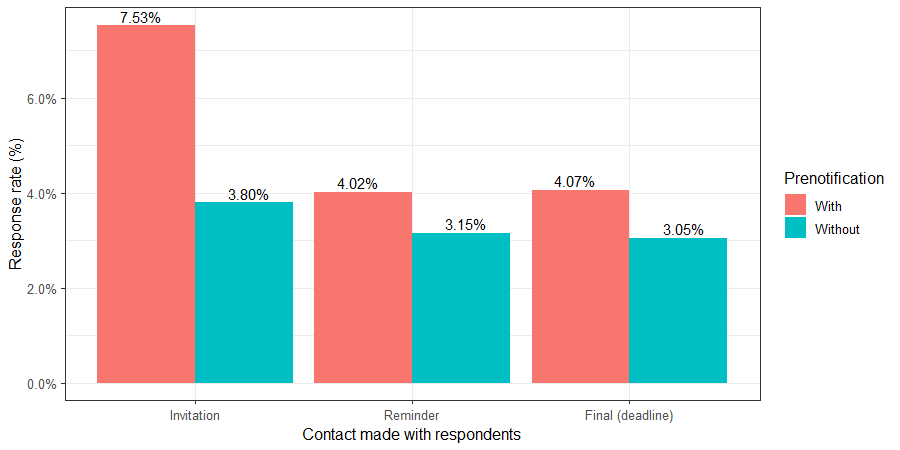Text Message (SMS) Pre-notifications, Invitations and Reminders for Web Surveys
Andreadis, I. (2020). Text Message (SMS) Pre-notifications, Invitations and Reminders for Web Surveys in Survey Methods: Insights from the Field, Special issue: ‘Advancements in Online and Mobile Survey Methods’. Retrieved from https://surveyinsights.org/?p=13551. The data used in this article is available for reuse from http://data.aussda.at/dataverse/smif at AUSSDA – The Austrian Social Science Data Archive. The data is published under the Creative Commons Attribution-ShareAlike 4.0 International License and can be cited as: “Replication Data for: Andreadis, Ioannis, 2020, Text Message (SMS) Pre-notifications, Invitations and Reminders for Web Surveys (OA edition)”, https://doi.org/10.11587/DX8NNE, AUSSDA.
© the authors 2020. This work is licensed under a Creative Commons Attribution 4.0 International License (CC BY 4.0) 
Abstract
This paper presents the findings derived from a mobile friendly web survey, during which all invitations and reminders were sent as text messages via short message service (SMS) to the mobile telephones of the target group. The web survey under study was conducted for the National Theatre of Northern Greece (NTNG), the largest theatrical organization of Greece. The list of mobile phone numbers was provided by the organization and the aim of the survey was to collect data from people who have attended events organized by NTNG. The paper examines the impact of various design study features such as pre-notifications, time and day of SMS delivery, lag between invitations and reminders on survey response. It is demonstrated that SMS pre-notifications can significantly improve response rates. The paper suggests that when the mobile phone numbers of the target group are available, it is feasible to conduct a large-scale web survey using SMS as the only contact mode.
Keywords
mobile surveys, pre-notifications, response rate, short message service (SMS), text message, Web surveys
Copyright
© the authors 2020. This work is licensed under a Creative Commons Attribution 4.0 International License (CC BY 4.0) 
Introduction
The use of text messages in surveys
Text messages or Short Message Service (SMS) are a typical feature of mobile telephones, and according to Dal Grande et al. (2016) SMS have been used for many years in businesses to remind clients of their appointment times and dates. Text messages may provide a new way to increase the efficiency of the data collection in surveys and especially in mobile web surveys.
In one of the first publications on the response rates in surveys whose invitations are sent via text messages, Hansen and Pedersen (2012) have reported for a panel survey that SMS yields lower response rates than email invitations, postal letter invitations, or telephone invitations. In their effort to explain this finding, Hansen and Pedersen argued that SMS is less effective than email because an email invitation with a link to the questionnaire provides easier access to the web survey than an SMS. Moreover, SMS is less effective than a postal letter or telephone simply because the message is one-way and very short, and thus less persuasive than the messages that can be conveyed in other modes. Mavletova and Couper (2014) agree that “SMS offers a rather limited opportunity to convince respondents to participate in the survey” (p. 501) and they also raise the issue of the cost per message. If a researcher wants to send more messages or a longer message that is split into separate messages since the maximum length of an SMS is 160 characters, these additional messages will increase the total cost of the survey.
On the other hand, as de Bruijne and Wijnant (2014) argue, text messages have a significant advantage as an invitation mode for surveys over emails: An email invitation is usually displayed in the inbox of sample members among many unsolicited emails and the recipient may ignore or even delete it along with the unwanted messages. On the contrary, people rarely receive unwanted text messages. In addition, when SMS invitations to a web survey are sent to smartphone owners, the sample member may access the questionnaire directly on their device with a simple tap on the link in the text message (De Bruijne & Wijnant, 2014). Thus, smartphone owners may follow the survey link much easier than owners of mobile telephones without Internet access, who would have to copy the link to a PC or another device with Internet access.
According to Mavletova and Couper (2016), the main reason of earlier research findings reporting lower participation rates to web surveys from SMS invitations compared to email invitations was the lack of mobile Internet access at the moment of receiving the SMS. As a result, they argue that “with the proliferation of internet-enabled mobile devices, SMS invitations have been found to produce similar overall participation rates” (Mavletova & Couper, 2016, p. 527). In fact, in a more recent publication, Lee, Kim, Couper, and Woo (2019) report that a smartphone web survey had a higher completion rate (41%) than a PC web survey (34%).
Text messages have been used as method of invitation and as reminders for various data collection modes and there are mixed findings about their effectiveness depending on the country, year of data collection, and data collection mode of the survey. A mail survey experiment in Finland, a country where almost everyone owns a mobile phone, showed a significant difference in response between sample members who received SMS reminders and sample members who received postal mail reminders, indicating that SMS reminders may improve mail survey response rates more efficiently than traditional postcard reminders (Virtanen et al., 2007). The findings were opposite in the USA: when text messages were sent to 217 mobile phone numbers that had no actual contact (e.g., no answer, busy, voicemail, or other types of automated messages) after 10 call attempts, only two of them completed the interview (Link et al., 2007).
Research questions
The main objective of this paper is to study participation behavior in a web survey that uses text messages for pre-notification, invitation, and reminders. One of the ways to increase participation in web surveys is by sending reminders (Fan & Yan, 2010). Although there is evidence suggesting that more reminders can increase response rates, it is difficult to determine the optimal number of reminders and some scholars suggest that sending more than three or four messages (including the initial invitation) is not effective (Muñoz-Leiva et al., 2010; Sánchez-Fernández et al., 2012). Moreover, when reminders are sent as text messages, researchers have to consider that —contrary to email reminders — each additional SMS reminder increases the cost of the survey. Thus, my first research question pertains to the effect of text message reminders on web survey participation.
RQ1: Do multiple SMS reminders increase participation in web surveys?
Another important question regarding the reminders has to do with the length of waiting time between messages. Deutskens et al. (2004) argue that the timing of sending email reminders does not significantly change the response rate. Lemon (2007) argues that people either will respond immediately — the majority of them within 36 hours — or they will not respond at all. Most studies that use text messages to recruit survey respondents report a very fast reaction from respondents (De Bruijne & Wijnant, 2014). McGeeney and Yan (2016) verify that sending text messages is associated with faster response. Balabanis, Mitchell and Heinonen-Mavrovouniotis (2007) examine the use of SMS on mobile phones to recruit samples for probability web and telephone surveys, and they report that the main advantage of using SMS is the high speed of response. My second research question thus pertains to the time it takes for invited sample members to respond to the survey after the invitation is sent:
RQ2: How long does it take sample members to participate in the web survey after the receipt of an SMS invitation?
Regarding protocols for contacting mobile phones, Link et al. (2007) reported that weekday evenings are more productive for achieving contacts than daytime and that weekend calling is less productive. Vicente, Marques and Reis (2017) studied the effect of call patterns on the likelihood of making contact and of obtaining an interview in a mobile CATI survey and they found that Tuesdays and Wednesdays are the worst days to make contact and obtain cooperation. However, all the aforementioned studies focused on the best time to call sample members on their mobile phones. To the best of my knowledge, there are no studies exploring the best time to send SMS invitations for a web survey. Thus, I formulate the following research question:
RQ3: Does the timing of the SMS invitation influence participation behavior in a web survey?
The impact of pre-notifications on the success of a survey has been studied by many survey methodology scholars. Focusing on pre-notification via text messages, Steeh, Buskirk and Callegaro (2007) conducted an experiment in the U.S. to test the hypothesis that sending a text message in advance would increase the response rate in a survey of telephone interviews. They found little support for their hypothesis. Conversely, a more recent study in Australia showed that sending pre-notification text messages to inform users of an imminent mobile phone call improved response and cooperation rates (Dal Grande et al., 2016). Amaya et al. (2018) tested the impact of SMS notifications prior to an interactive voice response (IVR) contact in Ghana, Malawi, and Nigeria, and found that the SMS pre-notification reduced the contact rate and improved the completion rate in all three countries, but only two of the six comparisons reached statistical significance. Bosnjak et al. (2008) compared the effectiveness of different pre-notification and invitation procedures in a web-based panel survey and found that the combination of SMS pre-notification and email invitation yields higher response rates than other combinations. The mixed findings presented in the literature motivate the formulation of the fourth research question of this paper.
RQ4: Do SMS pre-notifications influence participation behavior in a web survey?
Given that each text message is associated with additional costs and sending additional reminders has diminishing returns (Muñoz-Leiva et al., 2010; Sánchez-Fernández et al., 2012), survey researchers might want to consider trade-offs between sending a pre-notification SMS and sending an additional SMS reminder. Thus, my fifth research question is:
RQ5: Is it more efficient to send a pre-notification SMS or an additional SMS reminder for a web survey?
Mavletova and Couper (2014, 2016) reported that sending invitations as text messages instead of email messages significantly increased the share of respondents who used their mobile devices instead of their PC to complete a web survey. McGeeney and Yan (2016) also found that sending text messages to consenting survey panel members increased the share of respondents who completed the survey on a mobile device. Survey designers who would like to use SMS invitations need to know how many of their sample members will use a smartphone to access the web survey, because this knowledge will help them understand how crucial it is to design a questionnaire optimized for smartphones, for example, using large font size, large buttons, one question per page, short questions and short sets of response lists to minimize vertical scrolling (Andreadis, 2015a, 2015b). If sample members use their smartphones and the web survey is not mobile friendly, they may abandon the survey. This leads to the last research question of this paper:
RQ6: What devices do respondents use for web survey completion when they are contacted via SMS?
Data and methods
In this paper, I present the results of a web survey, in which all invitations and reminders were sent as text messages via SMS to the mobile phones of the target group. The design of the survey was mobile friendly, that is, all decisions regarding the appearance of the survey were made to improve the survey experience of smartphone respondents: we used large fonts, large buttons, one question per page, no horizontal scrolling, limited vertical scrolling, etc. The web survey under study was conducted for the National Theatre of Northern Greece (NTNG), the largest theatrical organization of Greece. A list of 13,028 mobile phone numbers of clients and friends of the NTNG was provided by the organization. The aim of the survey was to collect data from the people who had attended events organized by NTNG. The survey was conducted in July 2017. There were no incentives provided for survey participation.
The list of mobile phone numbers was used to send SMS pre-notifications without a link to the web survey, as well as SMS invitations and SMS reminders that both included a link to the web survey. SMS messages were sent using a web SMS gateway. The Greek acronym of the theatre “ΚΘΒΕ” was used as the sender designation in all text messages because this is how NTNG is widely known in Greece. Since the sender of the SMS was not a real mobile phone number, the recipients did not have the option to reply directly by SMS. The length of each message was set to be less than 160 characters to avoid splitting of messages and incurring additional costs. In order to minimize the length, the SMS invitations included a short text and a very short personalized link (of the form epolls.eu/XXXX). The messages did not include additional details about the survey or assurances of anonymity and confidentiality. This information was provided on the landing page displayed to respondents after they followed the link to the survey.
The online questionnaire included 36 questions/pages and the sample members were asked to express their opinion about various NTNG services. The median time to complete the survey was 10 minutes. In order to identify the type of device that was used by respondents (RQ6), a PHP script was coded to determine if the device was a personal computer, a tablet or a smartphone, using information provided by the user-agent strings of the respondents’ devices. The user-agent string is an identification string that is submitted by web browsers when they communicate with a web server. The string often contains information about the web browser itself, its operating system, software vendor or software version, and it can be used to classify the users’ devices. The type of device along with a timestamp of when the respondents had followed the survey link was stored in a database. I use the latter information to study the time it takes sample members to participate in the survey after the receipt of the SMS invitation (RQ2).
After sending the text messages, the SMS web management tool classifies them into one of four categories: delivered, expired, rejected, and undelivered. If the text message is delivered, the management tool also provides the timestamp of the delivery. Although most of the text messages were delivered, to avoid unnecessary charges, telephone numbers flagged as rejected were immediately removed from the sample. Expired and undelivered telephone numbers were also removed if their status did not change after a second attempt. After the removal of 446 cases, the final list of working mobile phone numbers consists of 12,582 cases.
The invitations were sent in the period between July 19 and 26, 2017 using the following wording: “THE NATIONAL THEATER OF NORTHERN GREECE NEEDS YOUR OPINION TO IMPROVE ITS SERVICES. TO PARTICIPATE GO TO: [link]”. Invitations were split into nine one-hour slots: four one-hour slots in the morning from 10:00 to 14:00 and five one-hour slots in the afternoon: from 17:00 to 22:00). The telephone numbers of the target group were randomly assigned to one of the time slots. The aforementioned time slots were selected in order to avoid the delivery of text messages during quiet hours. This design was implemented in order to answer the third research question, that is, whether the timing of the delivery of the SMS invitation has an effect on the participation behavior in a web survey. However, due to delivery delays and technical glitches, some messages were delivered during other time slots, most of them in the period between 22:00 and 22:59 (see Table 1).
Table 1. Number of invitations sent per day of the week and hour of the day
A first reminder was sent to numbers whose owners had not completed the survey on July 27 including the following text: “THIS IS A REMINDER TO PARTICIPATE IN THE NTNG SURVEY: [link] FOR INFO PLEASE CALL [phone_number] (MO-FR 9AM-4PM)”. A final reminder with a last notification to complete the questionnaire before August 4, was sent to sample members on July 31using the following wording: “IF YOU WISH TO MAKE YOUR OPINION COUNT IN THE SURVEY RESULTS, PLEASE COMPLETE THE NTNG QUESTIONNAIRE UNTIL FRIDAY 4/8: [link]”. I use the sequential order of reminders to study participation behavior after each text message (RQ1).
In order to answer research questions 4 and 5, the sample was randomly split into two groups. One half of the target group received a pre-notification SMS while the other half did not. The main aim of the pre-notification message was to inform the sample members that they were going to receive a second SMS with an invitation to a web survey soon. All pre-notifications were equally split along seven consecutive days (in the period between July 19 and 25) and they were sent between 9:00 and 10:00 in the morning of each day. The schedule of pre-notifications was aligned with the schedule of the corresponding invitations. The invitations were sent on the same day, after the pre-notifications and according to the aforementioned invitation time slots. To make sure that the two text messages were delivered in the correct order, an invitation was actually sent only after the pre-notification had been flagged as delivered. The exact text in the pre-notifications was as follows: “SOON, YOU WILL RECEIVE AN INVITATION TO A SURVEY BY THE NATIONAL THEATER OF NORTHERN GREECE. FOR INFO PLEASE CALL [phone_number] (MO-FR 9AM-4PM)”. From the 12,582 working mobile phone numbers, 6,296 received a pre-notification and 6,286 did not received a pre-notification SMS.
As a result, the 12,582 invitations were scheduled according to a 7 (day-of-week) x 9 (time-of-day) x 2 (pre-notification) between-subject design. Although, according to the original design, all sub-groups defined by each experimental factor should have been of equal size, some minor deviations could not be avoided due to the existence of invalid telephone numbers and delivery delays. For instance, there were cases of text messages that were delivered to the recipients during the following day (or days) after they had been sent because some mobile phones were not reachable.
In order to study participation behavior, we can observe the number of sample members who complete a survey, that is, the response rate. However, the completion of the survey depends on many other factors. For example, long self-administered questionnaires may suffer from lower response rates and higher drop-outs than shorter surveys (Andreadis & Kartsounidou, 2020). Thus, I evaluate participation behavior based on two outcomes: i) the share of invited sample members who clicked on the survey link, that is, the click-through rate, and ii) the share of invited sample members who completed the questionnaire, that is, the response rate.
Results
In the first part of this section, I focus on the general participation behavior of sample members invited to the web survey via SMS sent to their mobile phones regardless of the experimental group. Thus, in Table 2, I present results from the pooled dataset of 12,582 working mobile phone numbers.
Table 2. Participation behavior after each text message
Out of the 12,582 working mobile numbers, 1,028 (8.2%) sample members clicked on the survey link and 713 (5.7%) completed the survey. After the first reminder, an additional 576 (4.6%) clicked on the link and 451 (3.6%) completed the survey. The final reminder (including a deadline) was about equally effective: 535 (4.3%) additional people clicked on the link and 448 (3.6%) completed the survey. This finding confirms that multiple SMS reminders increase participation in web surveys (RQ1). Overall, from the people who clicked on the link, 75.4% completed the survey. The sample members who did not react at all can be classified as of unknown eligibility. For instance, the owner of the mobile phone number may have changed in the period between the time the mobile phone number was collected and the time the SMS invitation was delivered. Assuming that all contacted sample members were eligible, the minimum response rate of the study (AAPOR RR1) is 12.8%.
In order to answer the second research question, I present how long it takes for sample members to click on the survey link after the SMS invitation is delivered. It should be noted that although SMS are usually delivered in less than one minute, in some cases, it may take much longer for the message to get delivered. Thus, for accurate calculations it is better to use the time point of when the SMS was delivered and not the time point of when the SMS was sent.
Table 3. Time between SMS delivery and click on the survey link
Table 3 shows the distribution (in percentiles) of the difference between the time the invitation was delivered and the time the sample member clicked on the link to the survey. The analysis only includes the 1,028 sample members who clicked the survey link in the invitation. The findings are in line with previous research reporting fast reaction of respondents (e.g., De Bruijne & Wijnant, 2014). As Table 3 shows, one out of four of the sample members who clicked on the survey link, did so in less than 3.5 minutes. Moreover, half of the clicks on the survey link occurred in less than one hour and 95% of the clicks occurred in less than three days. In addition, more than 95% of the surveys were completed within 30 minutes after the click on the link.
Next, I examine whether manipulating the day of the week or the hour of the day of the SMS invitations influences participation behavior. As displayed in Figure 1, the day of the week affects neither the click-through rate (X2=6.50, df=1, p=0.370) nor the response rate (X2=1.87, df=6, p=0.931). Similarly, as displayed in Figure 2, the time of the invitation affects neither the click-through rate (X2=3.32, df=8, p=0.913) nor the response rate (X2=2.43, df=8, p=0.965).
The fourth research question can be answered by a comparison of participation behavior between the experimental SMS pre-notification groups. Figure 3 displays the click-through rate in each of the two groups after the invitation and the two reminders. One out of 10 sample members who received a pre-notification SMS clicked on the link to the survey after the initial invitation while the corresponding rate for sample members who did not receive a pre-notification is lower (X2=60.1, df=1, p<0.001). A similar pattern can be observed after the reminder text messages had been sent (reminder: X2=5.02, df=1, p=0.025; final reminder: X2=4.80, df=1, p=0.029). The overall difference in the click-through rates between the two groups is statistically significant (with pre-notification: 19.7%; without pre-notification: 14.3%; X2=66, df=1, p<0.001).
Figure 4 depicts the percentage of completed surveys by pre-notification group after each contact. The displayed pattern is similar to the pattern observed in Figure 3 for clicks on the survey link. After every text message, the number of completed surveys is higher in the group with a pre-notification SMS than in the group without. The difference of completed surveys between the two groups is significant after each contact (invitation: X2=81, df=1, p<0.001; reminder: X2=6.62, df=1, p=0.010; final reminder: X2=9.08, df=1, p=0.003). The overall response rate in the group with a pre-notification message is more than 5 percentage points higher than the response rate in the group without pre-notification (15.6% vs. 10%; X2=88, df=1, p<0.001).
Considering the aforementioned significant differences between the two groups, we should not overlook that the sample members in the pre-notification group received an additional text message that comes with the corresponding additional cost. For instance, after the invitation, the sample members in the group with a pre-notification received a total of two text messages and the sample members in the group without pre-notification received just one text message. It could be argued that instead of a pre-notification, survey designers could simply send an additional reminder message to yield similar results at the same costs. This brings us to the fifth research question, namely, what is more effective, a pre-notification message or on an additional reminder? In order to answer this question, I compare the response rates between the two pre-notification groups at the point when the samples had received the same number of text messages. In Table 4, I compare the total number and share of completed questionnaires in the pre-notification group after three text messages (pre-notification, invitation and first reminder) with the number and share of completed questionnaires in the group without the pre-notification message after three text messages (invitation, first reminder, and final reminder). According to the Chi-square test, the difference between the two groups is relatively small (1.5 percentage points) but statistically significant (X2=7.61, df=1, p=0.006), indicating that a pre-notification SMS increases participation over an additional reminder SMS.
Table 4. Number and share of completed surveys after three contacts (with vs. without pre-notification)
To answer the last research question, I am using data from the 2,139 unique participants who clicked on the survey link. As displayed in Table 5, most of the people (74.8%) who followed the survey link, did so on their smartphone. This finding replicates results of previous studies that text messages significantly increase the percentage of mobile web respondents (e.g., Mavletova & Couper, 2014).
Table 5. Device used to follow the invitation link
Discussion
This paper has demonstrated that when the mobile phone numbers of the target group are available, it is feasible to conduct a successful large-scale web survey using SMS as the only contact mode. The findings in this paper indicate that in case of SMS contacts, survey practitioners should send four messages (pre-notification, invitation and two reminders). Most respondents complete a survey within a very short time after the invitation was received (25% in less than 3.5 minutes, 50% within one hour, 95% within three days), indicating that survey designers should not expect any substantial activity to their web survey three days after sending an SMS. Thus, the data collection of a web survey that is based on SMS contacts can be completed within 10 days according to the following plan: 1st day: pre-notifications and invitations, 4th day: reminders, 7th day: final reminders including a deadline notification (e.g., that the survey will be available until the 10th day).
In addition, the findings of this paper are in line with the results of previous studies that the majority of respondents use their smartphone to complete the web survey (circa three out of four sample members who clicked on the survey link used a smartphone). This finding suggests that sending an SMS invitation and not optimizing for smartphones could be a mistake. A web survey that requires a lot of zooming and (horizontal) scrolling may increase response times and response burden (Andreadis 2015b). Increased response burden may lead to more drop-outs and lower response rates (Andreadis & Kartsounidou 2020). Moreover, the substantial number of people who used their PC, indicates that the invitation link should be short (e.g., similar to epolls.eu/XXXX or, if possible, even shorter) to make it easy for PC users to type it into the browser.
The findings presented in this paper which is focused on the impact of various parameters of the survey design (pre-notifications, time and day of SMS delivery, lag between invitations and reminders), show that SMS pre-notifications can significantly improve response rates. The pre-notification may be sent a few hours before the first main contact, namely, the invitation. However, the timing of the SMS invitation does not seem to have a significant impact on participation behavior.
Using text messages to invite individuals to smartphone-friendly web surveys seems to be a method with great potential. In fact, when the mobile phone numbers of the target population are known, sending text messages may be better than calling. For instance, when mobile phones are called, the circumstances at the moment of the call (e.g., the individual is busy, a noisy environment, the presence of other people nearby) may lead to shorter and less private conversations. These circumstances may have a serious impact on the decision of the contacted individual to participate in the survey and they may increase refusal rates (Carley-Baxter et al., 2010). Another issue associated with calls to mobile phones is related to mobile phone sharing. Busse and Fuchs (2013) report that most people who answer calls on other people`s mobile phones act “like a voluntary stand-in for the mobile telephone owner” (p. 8), meaning that they answer when the owner is absent or tied up with something else. All these problems associated with calling mobile phones may be diminished if SMS is used instead of calling, because text messages can be read later when the mobile phone owner is available and free of other obligations or distractions.
Although the findings of this paper are encouraging for the use of text messages in web surveys, it should be noted that findings can differ across countries in which the receiver of the SMS pays for the incoming message and countries in which the cost of the SMS is paid by the person or organization sending the SMS.
Another problem could be legal restrictions on contacting mobile phones. Under the Telemarketing Consumer Protection Act of 1991 in the U.S., it is unlawful to make any call using any automatic telephone dialing system without the user’s prior expressed consent. According to the 2010 Cell Phone Task Force AAPOR Report (Lavrakas et al., 2010), this restriction applies to all calls (including survey research calls) and could apply to text messages, too. This is the main reason that the AAPOR Task Force on Transitions from Telephone Surveys to Self-Administered and Mixed-Mode Surveys has concluded that “[t]ext message invitations and reminders are […] rarely practical for one-time surveys, but can be particularly useful for panel and longitudinal surveys where consent can be obtained” (Olson et al., 2019, p. 143).
The legislation is not as strict in the EU if the contact is made for purposes other than advertising, whereas sending commercial ads via SMS without prior consent is not permitted. According to the General Data Protection Regulation (GDPR), an organization that has collected data on the basis of legitimate interest, a contract or vital interests, can use the same data for statistics or for scientific research, even if this was not among the original purposes of data collection (see: https://ec.europa.eu/info/law/law-topic/data-protection/reform/rules-business-and-organisations/principles-gdpr/purpose-data-processing/can-we-use-data-another-purpose_en).
Finally, a limitation of this study is the lack of funds to follow up on individuals who had not reacted with an aim to learn more about their characteristics and the reasons for nonresponse. It would be useful to know if people who had not reacted to the text messages are systematically different from the people who had participated in terms of their mobile phone capabilities (e.g., internet access), age, other demographics or the variables of interest of the survey. Future research should address this limitation by calling individuals who did not react to the text messages to find out more about them.
References
- Amaya, A., Lau, C., Owusu-Amoah, Y., & Light, J. (2018). Evaluation of Gaining Cooperation Methods for IVR Surveys in Low- and Middle-income Countries. Survey Methods: Insights from the Field.
- Andreadis, I. (2015a). Comparison of Response Times between Desktop and Smartphone Users. In D. Toninelli, R. Pinter, & P. de Pedraza (Eds.), Mobile Research Methods: Opportunities and challenges of mobile research methodologies (pp. 63–79). Ubiquity Press. https://doi.org/10.5334/bar.e
- Andreadis, I. (2015b). Web surveys optimized for smartphones: Are there differences between computer and smartphone users? Methods, Data, Analysis, 9(2), 213–228. https://doi.org/10.12758/mda.2015.012
- Andreadis, I., & Kartsounidou, E. (2020). The Impact of Splitting a Long Online Questionnaire on Data Quality. Survey Research Methods, 14(1), 31–42. https://doi.org/10.18148/SRM/2020.V14I1.7294
- Balabanis, G., Mitchell, V. W., & Heinonen-Mavrovouniotis, S. (2007). SMS-based surveys: Strategies to improve participation. International Journal of Advertising, 26(3), 369–385. https://doi.org/10.1080/02650487.2007.11073019
- Bosnjak, M., Neubarth, W., Couper, M. P., Bandilla, W., & Kaczmirek, L. (2008). Prenotification in Web-Based Access Panel Surveys. Social Science Computer Review, 26(2), 213–223. https://doi.org/10.1177/0894439307305895
- Busse, B., & Fuchs, M. (2013). Prevalence of Cell Phone Sharing. Survey Methods: Insights from the Field. https://doi.org/10.13094/SMIF-2013-00004
- Carley-Baxter, L. R., Peytchev, A., & Black, M. C. (2010). Comparison of Cell Phone and Landline Surveys: A Design Perspective. Field Methods, 22(1), 3–15. https://doi.org/10.1177/1525822X09360310
- Dal Grande, E., Chittleborough, C. R., Campostrini, S., Dollard, M., & Taylor, A. W. (2016). Pre-Survey Text Messages (SMS) Improve Participation Rate in an Australian Mobile Telephone Survey: An Experimental Study. PLOS ONE, 11(2), e0150231. https://doi.org/10.1371/journal.pone.0150231
- De Bruijne, M., & Wijnant, A. (2014). Improving Response Rates and Questionnaire Design for Mobile Web Surveys. Public Opinion Quarterly, 78(4), 951–962. https://doi.org/10.1093/poq/nfu046
- Deutskens, E., de Ruyter, K., Wetzels, M., & Oosterveld, P. (2004). Response Rate and Response Quality of Internet-Based Surveys: An Experimental Study. Marketing Letters, 15(1), 21–36. https://doi.org/10.1023/B:MARK.0000021968.86465.00
- Fan, W., & Yan, Z. (2010). Factors affecting response rates of the web survey: A systematic review. Computers in Human Behavior, 26(2), 132–139. https://doi.org/10.1016/j.chb.2009.10.015
- Hansen, K. M., & Pedersen, R. T. (2012). Efficiency of Different Recruitment Strategies for Web Panels. International Journal of Public Opinion Research, 24(2), 238–249. https://doi.org/10.1093/ijpor/edr020
- Lavrakas, P., Blumberg, S., Battaglia, M., Boyle, J., Brick, M., Buskirk, T., DiSogra, C., Dutwin, D., Fahimi, M., Fienberg, H., Fleeman, A., Guterbock, T. M., Hall, J., Keeter, S., Kennedy, C., Link, M., Piekarski, L., Shuttles, C. D., Steeh, C., … ZuWallack, R. (2010). New considerations for survey researchers when planning and conducting RDD telephone surveys in the US with respondents reached via cell phone numbers.
- Lee, H., Kim, S., Couper, M. P., & Woo, Y. (2019). Experimental Comparison of PC Web, Smartphone Web, and Telephone Surveys in the New Technology Era. Social Science Computer Review, 37(2), 234–247. https://doi.org/10.1177/0894439318756867
- Lemon, J. (2007). The effect of reminder intervals on response rates for web surveys. In M. Trotman et al. (Ed.), ASC 2007. The Challenges of a Changing World. Proceedings of the Fifth ASC International Conference (pp. 103–111). Association for Survey Computing.
- Link, M. W., Battaglia, M. P., Frankel, M. R., Osborn, L., & Mokdad, A. H. (2007). Reaching the U.S. Cell Phone Generation: Comparison of Cell Phone Survey Results with an Ongoing Landline Telephone Survey. Public Opinion Quarterly, 71(5), 814–839. https://doi.org/10.1093/poq/nfm051
- Mavletova, A., & Couper, M. P. (2014). Mobile Web Survey Design: Scrolling versus Paging, SMS versus E-mail Invitations. Journal of Survey Statistics and Methodology, 2(4), 498–518. https://doi.org/10.1093/jssam/smu015
- Mavletova, A., & Couper, M. P. (2016). Device use in Web Surveys. International Journal of Market Research, 58(4), 523–544. https://doi.org/10.2501/IJMR-2016-034
- McGeeney, K., & Yan, H. Y. (2016). Text message notification for web surveys (Pew Research Center).
- Muñoz-Leiva, F., Sánchez-Fernández, J., Montoro-Ríos, F., & Ibáñez-Zapata, J. Á. (2010). Improving the response rate and quality in Web-based surveys through the personalization and frequency of reminder mailings. Quality & Quantity, 44(5), 1037–1052. https://doi.org/10.1007/s11135-009-9256-5
- Olson, K., Smyth, J. D., Horwitz, R., Keeter, S., Lesser, V., Marken, S., Mathiowetz, N. A., McCarthy, J. S., O’Brien, E., Opsomer, J. D., Steiger, D., Sterrett, D., Su, J., Suzer-Gurtekin, Z. T., Turakhia, C., & Wagner, J. (2019). Report of the AAPOR Task Force on Transitions from Telephone Surveysto Self-Administered and Mixed-Mode Surveys. In AAPOR.
- Sánchez-Fernández, J., Muñoz-Leiva, F., & Montoro-Ríos, F. J. (2012). Improving retention rate and response quality in Web-based surveys. Computers in Human Behavior, 28(2), 507–514. https://doi.org/10.1016/j.chb.2011.10.023
- Steeh, C., Buskirk, T. D., & Callegaro, M. (2007). Using Text Messages in U.S. Mobile Phone Surveys. Field Methods, 19(1), 59–75. https://doi.org/10.1177/1525822X06292852
- Vicente, P., Marques, C., & Reis, E. (2017). Effects of call patterns on the likelihood of contact and of interview in mobile CATI surveys. Survey Methods: Insights from the Field.
- Virtanen, V., Sirkiä, T., & Jokiranta, V. (2007). Reducing Nonresponse by SMS Reminders in Mail Surveys. Social Science Computer Review, 25(3), 384–395. https://doi.org/10.1177/0894439307299588


